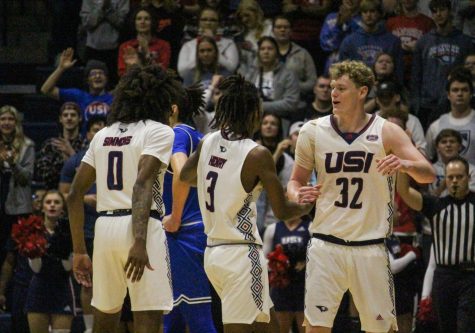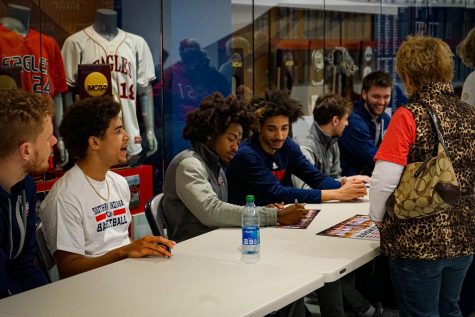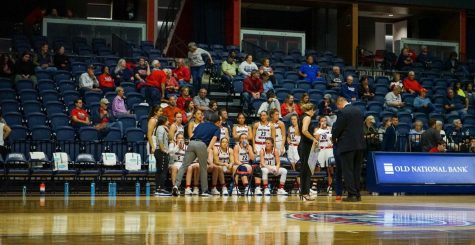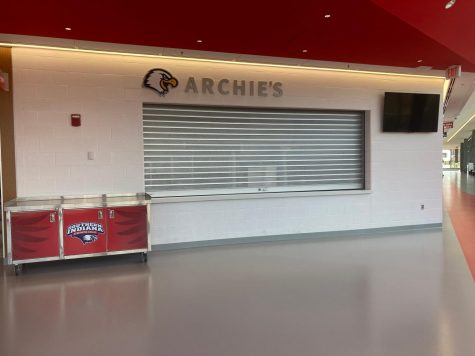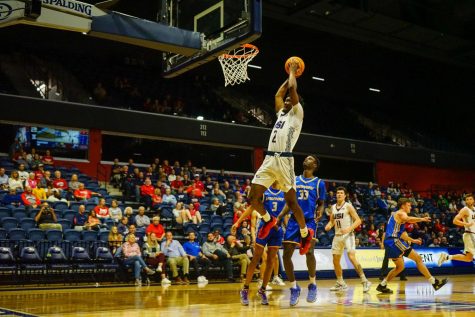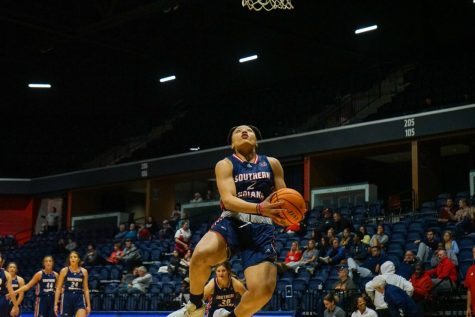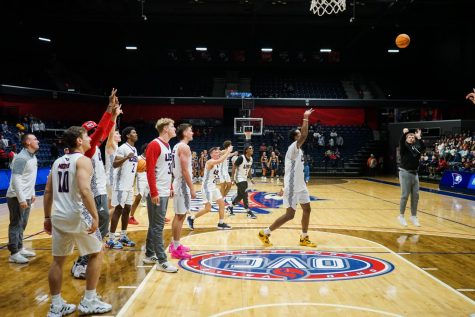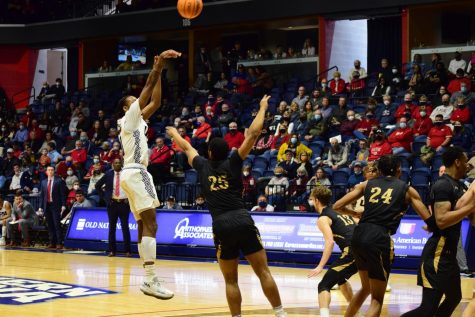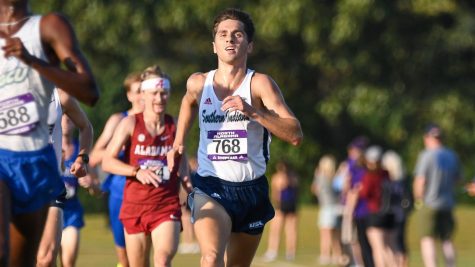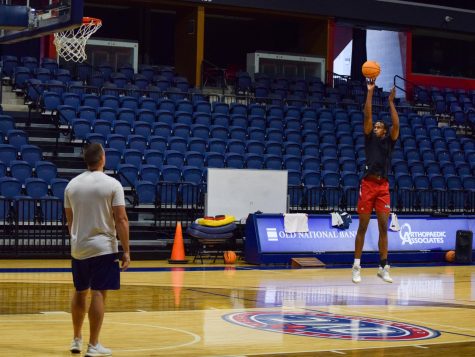Everything you need to know about DI
Common questions and answers about the possible transition of university athletics to Division I.
February 3, 2022
What’s going on?
The university is considering transitioning its athletics from NCAA Division II to Division I. The feasibility of the university transitioning to DI has been studied since September of 2021.
The Board of Trustees will make the decision on transitioning the university’s athletic program to Division I at 1 p.m. Feb. 7. in Carter Hall. The meeting will be livestreamed on the Carter Hall YouTube channel.
What is Division I?
Division I is the highest level of university athletics sanctioned by the NCAA. DI schools include major athletic powerhouses with larger budgets, more intricate facilities and more athletic scholarships.
The main difference between a Division I, II and III school is the amount of scholarships going toward athletics. DI gives the most scholarships, DII hands out some and DIII can make the choice to not give out scholarships at all, resulting in higher athletic competition at DI schools compared to DII and DIII schools.
Why is it a big deal?
The transition would mean all sports at the university would compete at the Division I level.
Being part of DI creates university exposure at a national or even a global level. This means recruiting could draw in more talent from all over. Division I schools also have the opportunity to compete in the March Madness tournament.
The university would have to recruit DI athletes and build a DI athletic program. The university’s athletic budget would have to double if the university transitions DI.
If the university goes DI, there will be two DI universities in Evansville, IN: University of Evansville and USI.
Why now?
The university was invited to join Division I by a DI conference in August 2021.
After President Ronald Rochon announced the study on Sep. 27, 2021, he created the Division I Exploratory Committee. The committee consists of 24 members from campus to conduct a study on the feasibility of the university transitioning to Division I.
How would it happen?
To become a DI school, a university must host at least seven sports for both men and women with two team sports for each. For sports other than football and basketball, teams are required to play 100% of their contests against other DI schools.
A university that is Division II or Division III can apply for a specific sport to be DI as long as they meet the standards. For example, in the 1992-93 school year, the university’s men’s soccer team transitioned to DI and stayed there for 3 years.
If the university athletic program has these requirements and are accepted by a DI conference, they can apply to the NCAA for reclassification.
At USI, if the Board of Trustees decides to apply for DI, university athletics would begin the application process and the process of raising funds to finance DI. University athletics would also not be allowed to compete in the postseason for five years.
How much would it cost?
There is a fee that needs to be sent to the NCAA for reclassification from DII to DI. The fee is estimated to be $1.7 million dollars, however it will be refunded if the application is denied.
The current athletic budget of the university is $6.6 million. The DI Exploratory Committee predicts the transition would increase the budget to $12 million. During the committee co-chair presentation on Dec. 2, 2021, it was revealed that the $5.4 million dollar gap would be filled through student fees, private donations and fundraisers.
The student fee would slowly increase for students over four years. The ending student fee is projected to be $475 a year.
How well would campus be able to make the transition?
The DI Exploratory Committee released their final report Jan. 13 on the feasibility of the university transitioning to Division I.
The 50 page report contains 26 items reviewed by the committee to determine the readiness of the university to transition to Division I. Each item was graded on a scale of one to three: one being ready to transition, two being minor adjustments and three would mean more than minor adjustments.
Five of the items were ranked as a one. Academic quality of the university was listed in this category, and according to the report, “None of the academic standards or entrance requirements at USI would need to be adjusted to make the transition to Division I.”
Eleven of the items were ranked as a two. Ensuring student-athletes have sufficient time for academic programs, categories that applied to budget and academic rules were in this section. According to the committee’s report, “Existing policies should be enhanced to ensure that student-athletes have time for their studies as frequency and duration of travel time for Division I athletics will likely increase over Division II athletics.”
Ten of the items were listed as a three. Multiple categories involving the student-athlete experience are in this section. Others listed include staff positions, marketing and athlete protections. According to the report, “USI does not have any marketing or development staff that solely work within athletics.”
How does the campus community feel about it?
The exploratory committee released the DI survey results Jan. 5. The DI survey was emailed to the campus community Dec. 6, 2021 and closed Dec. 19, 2021, at midnight.
The survey contained an FAQ with 13 questions and answers about cost, student fees and how transitioning athletics to NCAA Division I would affect the university. Participants could answer yes, no or don’t know to the question, “Based on the information provided in the FAQ, in general, are you in favor of USI competing at Division I level?”
Around 39% of the 2,233 participants were in favor of university athletics competing at NCAA Division I level with 49% not in favor and 12% unsure.
Around 22% of the 257 participating faculty members were in favor with 60% not in favor and 18% uncertain. Around 44% of the 1,381 participating students were in favor, 48% not in favor and 8% uncertain.
Around 45% of participating student athletes were in favor and 45% were not in favor with 10% uncertain.
Could USI compete at a DI level?
There has been concern on campus on whether or not the university can stand their own in DI contests. The university joined the NCAA Division II in 1976, and later, they helped create the Great Lakes Valley Conference in 1978. Men’s basketball became a top 10 team the following year.
All 17 varsity sports have won the GLVC conference championship and/or made an NCAA Tournament appearance since 1990. The university has won a total of four National Championships: men’s basketball, 1995; baseball, 2010 and 2014; softball, 2018.
In 1994, the men’s basketball team would earn their first number 1 rank and go on to win their first National Championship. In 1997, the men’s and women’s teams became the first teams to both be ranked number one.
In recent years, cross country has been competitive with the men holding a 12-year GLVC Champion streak. While the women tallied 13 total GLVC championships, eight of those have come during the last nine years.
The university not only has a rich history of competing, but the future looks bright with more university expansion.
In Spring 2019, the Screaming Eagles Arena debuted. Seating around 4,800 people, the arena is home to basketball and volleyball.
In Spring 2022, the creation of a 25-men and 25-women swimming and diving team was announced. The teams will compete in the university’s Aquatic Center. The Aquatic Center opened in Fall 2021 with a plan of 10 meets to start the opening season in Fall 2022.
While it’s up in the air whether the athletics program can hold up in Division I, the university has been competitive in Division II over the years, both within our conference and nationally.








